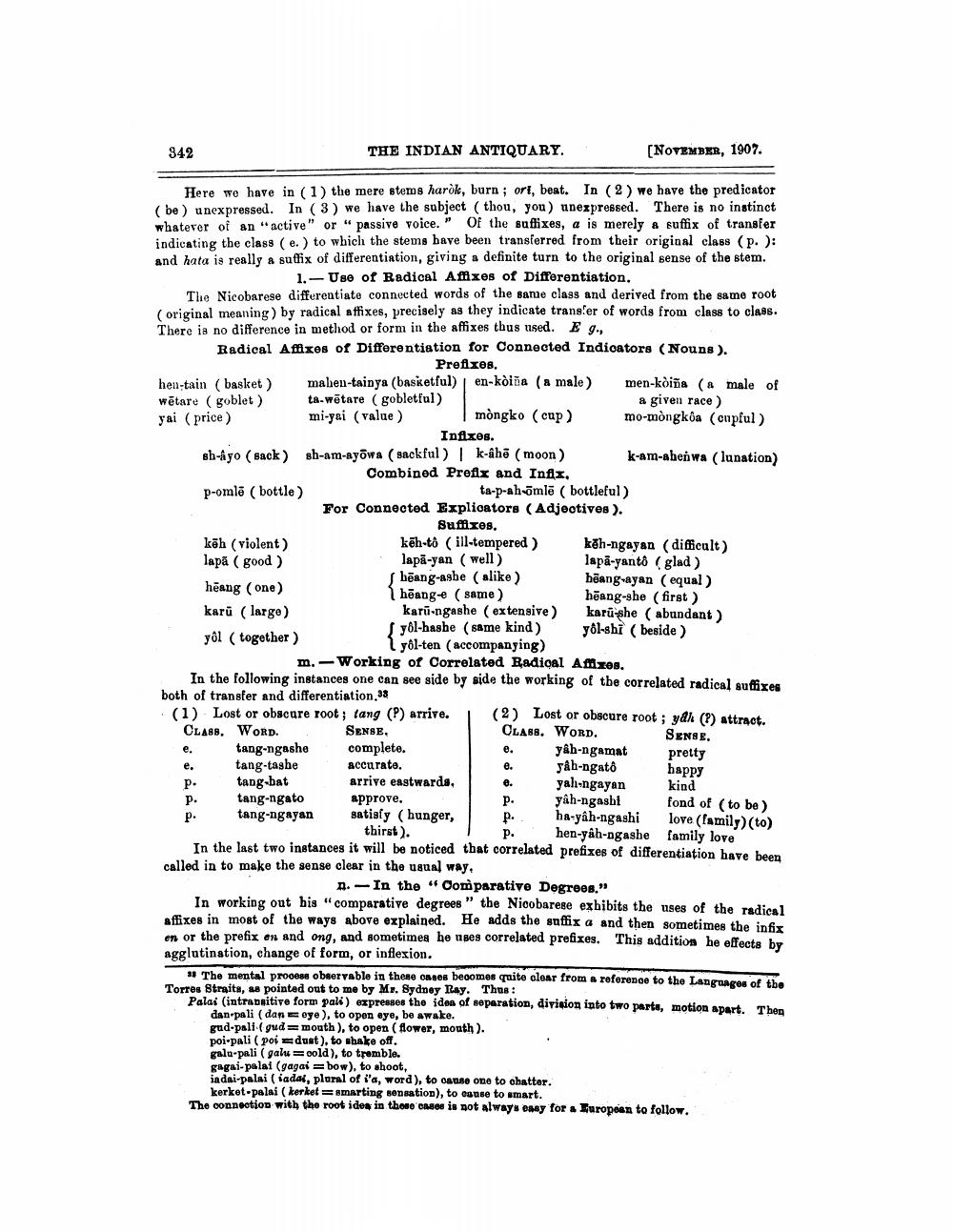________________
942
THE INDIAN ANTIQUARY.
[NOVEMBER, 1907.
Here we have in (1) the mere stems haròk, burn; ort, beat. In ( 2 ) we have the predicator (be) unexpressed. In ( 3 we have the subject (thou, you) unexpressed. There is no instinct whatever of an "active" or " passive voice." Of the suffixes, a is merely a suffix of transfer indicating the class (e.) to which the stems have been transferred from their original class (p.): and hata is really a suffix of differentiation, giving a definite turn to the original sense of the stem.
1.- Use of Radical Affxes of Differentiation, The Nicobarese differentiate connected words of the same class and derived from the same root (original meaning) by radical affixes, precisely as they indicate transfer of words from class to class. There is no difference in method or form in the affixes thus sed. E g., Radical Affixes of Differentiation for Connected Indicators (Nouns).
Prefixes. hen-tain (basket ) maben-tainya (basketful) en-kòiña (a male) men-kòiña (a male of wētare (goblet) ta wētare (gobletful)
a given race ) yai (price)
mi-yai (value) móngko (cup) mo-mòngkoa (cupful)
Infixes. sh-ayo (sack) sh-am-ayowa (sackful) | k-ahē (moon) k-am-abenwa (lunation)
Combined Prefix and Infis, p-omlē (bottle)
ta-p-ah-āmlē (bottleful) For Connected Explicators (Adjootives).
Sufixes. kēh (violent)
kēn-tó (ill-tempered) kah-ngayan (difficult) lapā (good)
lapā-yan (well)
lapa-yanto (glad ) s bēang-asbe (alike) hēang-ayan (equal) heang (one)
hēange (same)
hēang-she (first) karů (large)
karü.ngashe (extensive ) karū-she ( abundant)
S yol-hashe (same kind) yol-shi ( beside ) yol (together)
yol-ten (accompanying) m. - Working of Correlated Radioal Axes. In the following instances one can see side by side the working of the correlated radical suffixes both of transfer and differentiation,38 (1) Lost or obscure root; tang (P) arrive. (2) Lost or obscure root; ydk () attract. CLA8B. WORD. Sense. CLABB. WORD.
SENSE tang-ngashe complete.
yâh-ngamat pretty tang-taghe accurate,
yâh-ngató bappy tang-bat arrive eastwarda,
yah-ngayan tang-ngato approve.
yâh-ngashi
fond of (to be ) tang-ngayan satisfy (hunger,
ha-yâh-ngashi love (family) (to) thirst).
p.) hen-yâh-ngashe family love In the last two instances it will be noticed that correlated prefixes of differentiation have been called in to make the sense clear in the usual way,
n. - In the “Comparative Degrees." In working out his comparative degrees " the Nicobarese exhibits the uses of the radical affixes in most of the ways above explained. He adds the suffix a and then sometimes the infix en or the prefix on and ong, and sometimes he uses correlated prefixes. This addition he effects by agglutination, change of form, or inflexion.
# The mental process observable in these casos becomes quite clear from a reference to the Languages of the Torres Straits, as pointed out to me by Mo. Sydney Ray. Thus: Palai (intransitive form pali) expresses the idea of separation, division into two parts, motion apart. Then
dan-pali (dan eye), to opon eye, be awake. gud-pali (gud=month ), to open (flower, mouth). poi.pali (poi sdust), to shake off. galu-pali (galu =cold), to tremble. gagai-palai (gagai =bow), to shoot, ia dai-palai (ladat, plural of i'a, word), to ono one to chatter.
kerket.palai (kerket =smarting sensation), to cause to smart. The connection with the root idow in those cases is not always may for a Luropean to follow.
kind
p.




